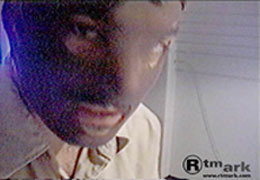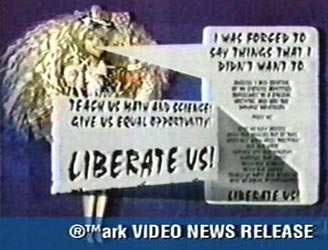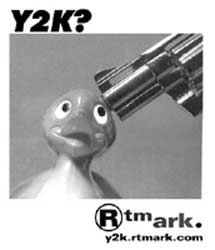|
|
|||||||||||||||||||||
1. Fighting the Terrorists
|
 |
Wired, February 1998: activist cyber-terrorists bring it all crashing down. Almost: a John-Wayne type in the Pentagon saves us. The ultimate shock of the future, this, the whole earth brought to its knees by a cold, faceless entity, destructive but aimless: nothing human about it, its only manifestation a logo, a slogan, momentum, and some vague propaganda. In other words, corporate power. In the techno-corporate cybercult for which Wired is a sacred text, it is dogma that there are no centers, no certainties, just ceaseless flux. But the cult of course has some tenets, among them:
Power is no longer in government.
The human body is no longer the ultimate creation.
The new power is corporate and virtual.
Computer technology will one day replace the human brain.
Opposition to the new power endangers us all.
It is foolish and short-sighted to deny this.This "paradigm shift," as it is called by the self-proclaimed "digerati," has two levels: the corporate/pragmatic, that shows up in Wired, and the fully theoretical and abstract, decreed by the likes of Marvin Minsky, Hans Moravec, et al. These mystical halves, which complement and depend on each other, define an instant split-level religion. The more extreme half, full of apocalyptic predictions, serves to contextualize and make more exciting the worldly assertions of the other. This latter more accessible but still privileged sanctum, constantly outlined in Wired and other corporate literature, is the catechism in action; it allows the cult's mostly managerial-class adherents to feel themselves part of something millenial, and--perhaps the raison d'ętre of the whole edifice--it casts their entrepreneurial amorality as exalted, and ordains it. As in any religion--or millenial world view--opposition, implied or real, is both needed and despised, essential and unthinkable.
For the cybercult, since scapegoating is so unfashionable and no real opposition exists, an enemy is invented. "Cyber-terrorism," unlike the Jews, does not seem to have a real-world component (appropriately enough for a virtual religion), but it serves well as the shadow and enemy of corporate power, displacing any lingering unconscious unease with the new order onto something that looks just like it but stands as its opposite, and that never needs be confronted (except by Harrison Ford, the updated John Wayne). And it taps in well to the "terrorism" that has replaced Communism as the televized enemy for the culture at large.
| 2. Fighting the Terror |  |
The popular glorification of corporate power, in whatever form it takes--techno-utopianism, techno-paganism, etc.--is misguided and weak-minded at best, considering what is known about how corporations behave. In fifty years the "cybercult" may look like the boosterism of television, the automobile, or the atomic bomb looks to us now--or it may look like certain impressive rallies burnt hard on our retinas. The sort of demonization inevitable at the end of the hype, delirious as it may seem, may (conceivably) portend a real challenge to the notion of constructive sabotage, especially if "we"--those who do not buy into the techno-corporate cybercult, and who fight the system it worships--are at all successful. But what is really frightening about the cybercult's fanciful enemy is that it points up a certain lack--at least perceived--of an actual one. Since corporate power has indeed become globally ascendant, as the "digerati" assert, a possible lack of solid opposition is frightening.
ŪTMark's original (and excessively optimistic) intent was to help remedy this situation. Our first task was to examine the special conditions to which the lack of resistance might be ascribed. The history of ŪTMark can be seen as an evolution in our thinking on this matter. In approaching the problem of opposing corporate power, we immediately had to acknowledge that corporate power is different, essentially and perceptually, from the government power against which there is such a long and varied tradition of resistance. Corporate power is alien and faceless, a disembodied, unlocalized, inhuman force that constantly thrusts itself upon us, but has only a multitude of seemingly dissociated aims and no position we can count on, or against which we can fight. Its horror can't even be named--neither "kafkaesque" nor "orwellian" will really do, because in Kafka and Orwell the nightmarish forces ostensibly emanate from a malevolent or amoral government, not from countless disembodied entities that, like wraiths in a video game, can never conceivably be destroyed all at once by any weapon, ideological or physical.
Luckily for the activist, the flexibility of corporate power, its lack of a center, comes at a price: it has no brain. It may be as tenacious as a virus, but it also has the intelligence of one: mechanical, soulless, miniscule. It is very easy to attack, and unlike government, it usually reacts to attack by mutation--which makes for its durability, but also gives protest unprecedented power to achieve immediate results, however evanescent they turn out to be. This mutating quality led ŪTMark to settle on widespread, individually-conceived product sabotage as a viable method of combating corporate power. With a sustained barrage of attacks, it was reasoned, substantial changes might be effected. These changes might not be permanent, but the barrage could be. In order to position itself as a permanent fixture rather than as an interim solution, ŪTMark decided to model itself after corporations, i.e. not model itself at all, and define itself only by logos and slogans. The pronouncements in this paper, earnest as they are, do not define ŪTMark; ŪTMark is defined by the way it is perceived and used, and our only face is our graphics, sound bytes, and occasional products. ŪTMark, like a corporation, adapts and mutates as conditions necessitate, in service to its bottom line: opposition.
It is easy, given the discouraging mutability of corporate power, the impossibility of determining a single characteristic or creed that defines it, to fall into the trap of choosing to believe that it is relatively benign. Since so little is really known about it, almost all hypotheses seem equally valid, and it is easiest, after all, to accept the most pleasant. In this case, the most pleasant is that the shift of power from governmental to corporate represents an improvement. Since governments are often quite bad--we know this, because of the Nazis and because anti-government protest has told us this for at least hundreds of years--it stands to (unexamined) reason that what remains after the evaporation of government will be good. The desire to see corporate power as benign, even in the face of all evidence, is understandable. Since this desire renders the fight against corporate power difficult, even with the machinery in place, ŪTMark decided, in 1997, to shed its veil of secrecy and attempt to act as a nexus for perceptions and insecurities about corporate power and the struggle to fight it. ŪTMark was also spurred by the publicizing of another group's large reward for the year's best act of "creative sabotage," which we perceived to indicate a need for a public anti-corporate presence. We began by encouraging previous ŪTMark workers to speak with the media, and by replacing the dial-in system with a web site. While this change has not dramatically increased the number of actions ŪTMark has been able to sponsor, it has allowed ŪTMark to publicize them in a manner that would have been impossible before. In at least two cases, this has resulted in widespread coverage that probably would not have occurred otherwise.
By becoming more public, ŪTMark has also come to serve as a sort of public space where anti-corporate activists can meet each other online. If we judge our success at this as a corporation might, using typical benchmarks, we come away quite encouraged. In the eight or so months since our move to the Web, our site has received nearly twenty thousand visits, and several ongoing collaborations have resulted from our matchmaking efforts. And we can only assume that some of those who see the ŪTMark site, or who hear about us in the press, will find their own ideas sparked.
| 3. The Mutual Fund System |  |
Considering ŪTMark's long-term aim of establishing a permanent and significant opposition to corporate power, however, we were forced to acknowledge in 1998 that our successes had until then been exceedingly modest. We continued to believe in widespread individually-conceived sabotage as a means of fighting the hydra that is the corporate, but had to admit that even our shift to a more public mechanism had at best barely begun to effect the indomitable resistance that has always been our agenda. To determine our next course of action, we turned our attention to a system that in fact inhibits the critique of corporate power at a purely mechanical level: the stock market. By interesting nearly everyone in corporate welfare through ownership of stocks or mutual funds, corporations have created a conservative majority whose bottom line is the same as their own, consciously and unconsciously: what's good for GM is good for me.
The media's positioning of economic news in the boldest headlines helps extend the effect even beyond those growing multitudes who own stock. ŪTMark felt it had to offer, perceptually if not actually, an alternative to the endless flow of bounty provided by the stock market. Much as the National Endowment for the Arts, even with its slim offerings, provided the illusion of an alternative to corporate systems--an illusion more important than the actual sums (and which has now vanished, along with the NEA's influence)--ŪTMark hoped to provide a similar illusory but conceptually powerful alternative to the "bottom line" of corporate power.
To effect such a perceptual change, and to create a steady stream of funding to replace the spotty financing our projects now enjoy, ŪTMark implemented its "mutual fund" system. Much as timid consumers can be convinced to wager their savings on corporate stocks by means of mutual funds, in which direct contact with the stocks is relegated to "experts," so we believed that by classifying projects according to theme, risk, and so on, and taking care of the specific details of allotment--as well as by extending ŪTMark's corporate protections to cover investors--we could assuage some of the fear that might interfere with investment in specific projects, and increase the cashflow available to our projects.
To increase this effect, we also recruited several "celebrity fund managers" who, having demonstrated their staying power as reliable producers of cultural dividends, are eminently suited to decide on distribution to the cultural enterprises our projects represent. By lending the power of their name to groups of projects, we felt they might interest investors who otherwise would be afraid of the cultural risk of supporting ŪTMark projects. The high profile lent by these managers would also help increase the perceived profile of the ŪTMark alternative.
|
Epilogue,
|
 |
We ended the original version of this article on a note that, in retrospect, strikes us as terrifically naive:
Luckily for the activist, the primary reason the new ascendancy of corporate power has been so meekly accepted is probably not its facelessness, nor the stock market, but rather simply its age. It has only been a short time since the model of the corporation has replaced that of government as a personal guiding metaphor, since we've stopped thinking of "fair government" in favor of "productive investment" (and since Harrison Ford replaced John Wayne). The old power regime, with all its metaphors, existed for hundreds of years, and protest had just as long to develop; the new techno-corporate mythology is still being formulated and implanted, and there has just not been time to learn how to fight it.
It may be that our current steady efforts will at some point reach a sort of "critical mass," at which time the idea of sabotage will lodge in the popular consciousness with the force necessary to effect widespread change, but we cannot count on this. Whether by the means we are currently considering, or by means we have yet to consider (and which may reach us from the public at large), we will continue to strive to expand ŪTMark's ability to combat corporate power and the ludicrous but dangerous mythologies that support it.
Until sabotage seems more natural and obvious than going to the coffee machine, ŪTMark will not be able to claim real success. Until conscientious resistance is so common that corporations anticipate it everywhere, and are constantly attempting to pre-empt it with conscientious behavior, ŪTMark will need to examine its methods and consider whether new ones might be more effective.
It is no longer even conceivable to us that product sabotage could ever reach the scale at which it could fundamentally change the balance of power between corporations and people, nor even affect it significantly. It is even possible that it could never reach that scale, that other mechanisms would come into play long before change occurred.
The value of ŪTMark is, and has always been, not in any real pressure it can possibly bear, but rather in its ability to quickly and cheaply attract widespread interest to important issues. ŪTMark is thus essentially a public relations agency for anti-corporate activism, using sensationalist framing--"sabotage," "financial muscle", etc.--to attract mainstream press interest to projects that, to one degree or another, illustrate the enormous abuses of corporate power against democracy and human life. ŪTMark serves not only to obtain such publicity by means of sensationalism, but to steer it through careful press-release writing and in interviews with the press.
The fact that the effect of ŪTMark-style projects is mainly pedagogical has led some people (including, at times, ourselves) to question whether they constitute activism at all. But this line of reasoning, pursued further, would also call into question whether the enormous protests against the WTO, the IMF, etc. are activism, either, since their primary effect has "merely" been to draw withering public attention to some tools of corporate abuse. Such a question, of course, is completely absurd. Of course, the power of enormous protests--direct (through immediate shutdowns) and, more importantly, indirect (through publicity and increased public awareness)--is immeasurably greater than that of ŪTMark-style activism. But this "smaller" activism does have the benefit that it can obtain very widespread, useful publicity quickly, at minimum cost, and with a minimum amount of planning and coordination. No assemblies need approve plans, and even individuals can accomplish something working nearly alone.
As for truly lasting gains, these can only be accomplished through legal solutions, whereby corporations are officially divested of the superhuman rights they currently enjoy... or by a degree of insurrection that's not entirely conceivable at present.
June 1, 1998, revised November 26, 2000